01.03.11
Posted in Weather Education at 8:00 am by Rebekah
Today I’d like to start a weather education series. While some of you may have a background in meteorology, others may be confused at times when I speak of instability and wind shear.
So, beginning with the basics and covering topics such as weather maps and severe weather forecasting, every Monday I will give a short lesson on meteorology. The blog posts will build upon each other, and eventually I will make a list of links to the posts and put it on my website.
————————————————–
What is meteorology?
Meteorology (also known as atmospheric science) is the study of the atmosphere and weather. Climatology is the study of climate.
What is the atmosphere?
The earth’s atmosphere is a thin layer of air extending from the earth’s surface to a height of about 12 km (7.5 miles).
Atmospheric composition:
- Nitrogen: ~78%
- Oxygen: ~21%
- Argon: ~0.93%
- Carbon dioxide: ~0.039%
- Water vapor: variable, from 0 to 4%
- Other trace gases, including ozone and methane
What is weather?
Weather is the state of the atmosphere at any given place and time. For example, the weather conditions at midnight New Year’s Eve 2010 in Seattle, Washington included a temperature of 27 °F, a relative humidity of 66%, calm winds, and clear skies.
Climate, in contrast, is the average weather at any given place over a long period of time. For example, the average high temperature in Seattle for the month of January, a component of the city’s climate, is 46 °F.
Why is there weather?
As described in last week’s post, “What If…We Could Prevent Storms From Occurring?“, the sun heats the earth unevenly (because of earth’s tilt). Some of this radiation is absorbed by the earth, which then emits longwave radiation back to space.
Long story short (check out that blog post for more detail), the tropics receive more radiation than they emit, and the poles emit more radiation than they receive. This means the tropics have a net surplus of radiation and the poles have a net deficit of radiation (see figure, below).
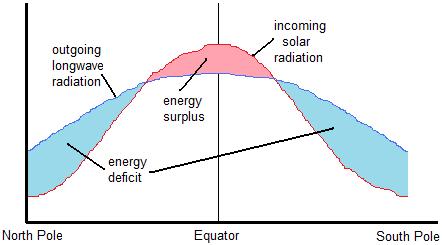
Earth’s Annual Radiation Budget
The earth is always trying to balance out inequalities, though, so warm air must get transported towards the poles, while cold air must get transported towards the tropics! This transfer of air is what drives our weather.
————————————————–
Come back next Monday to learn about the elements of weather, beginning with temperature and the layers of the atmosphere!
Permalink
01.02.11
Posted in Severe Weather Post-analysis, Weather News at 8:01 am by Rebekah
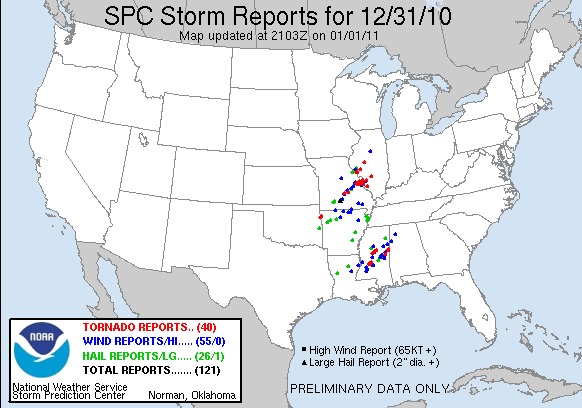
While 2010 had a slow start to the tornado season (see Where Have All The Tornadoes Gone?, Tornado Season So Far…, and Minnesota Leads U.S.; U.S. Back Near Average), it ended with a rare New Year’s Eve tornado outbreak.
40 tornadoes were reported between the morning of the 31st and the morning of the 1st. At least 7 people have died as a result of the twisters in Arkansas and Missouri.
Several of the tornadoes were rated EF3 on the Enhanced Fujita Scale, as lift from the big trough, warm, moist air ahead of an arctic cold front, and ample vertical wind shear provided the necessary conditions for strong tornadoes.
The last significant New Year’s Eve tornado outbreak occurred in 1947, when 20 people were killed and over 250 were injured.
So now that the year is over, how did 2010 stack up against the past few years in terms of tornadoes and tornado reports?
Tornado reports (2010 in red, ’05 to ’09 average in gray), from the Storm Prediction Center:
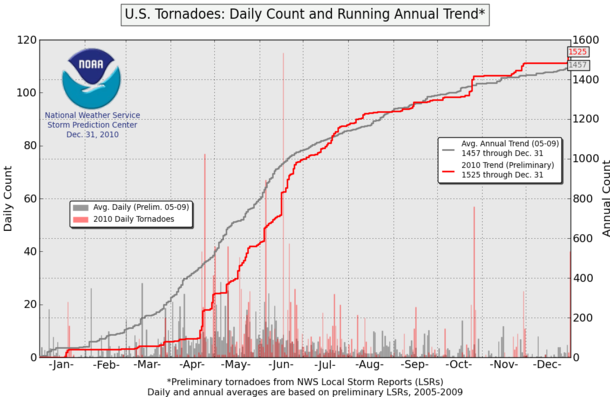
Note the year was below average until mid-July, at which point it fluctuated about the average and then ended just above average, with 1,525 tornado reports.
Tornado reports from ’05 through ’10, including the ’05 to ’09 average, in gray:
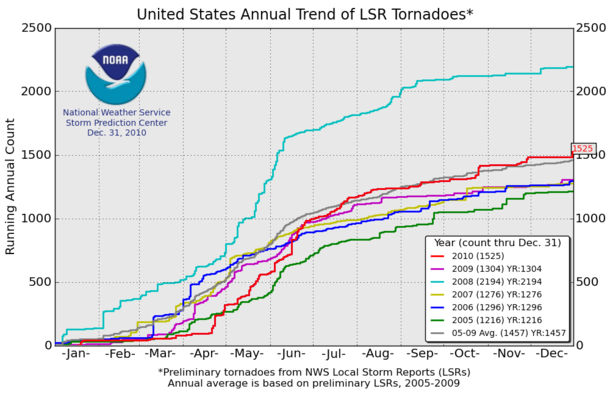
2010 was below the previous 5-year minimum until late April.
Adjusted tornado trend and percentiles (adjusted to account for over-reporting; for details on calculation, see SPC site):
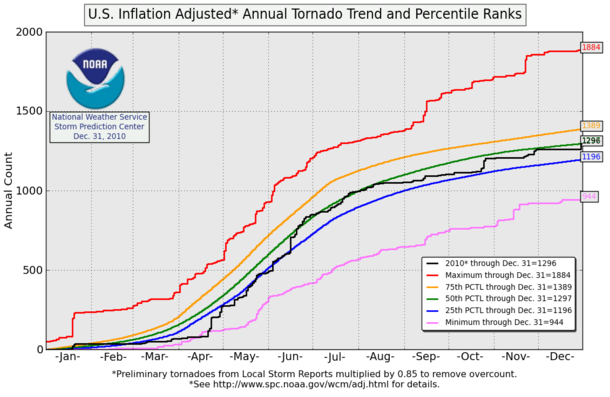
The estimated number of tornadoes in 2010 briefly dropped below the 1954 to 2007 minimum, before climbing up to just about the 50th percentile (the median). The year ended with an estimated 1,294 tornadoes.
For more detailed information on the New Year’s Eve 2010 tornado outbreak, check out the summaries/reports/photos from individual National Weather Service offices. Here are a few to get you started: Tulsa OK, St. Louis MO, Little Rock AR, and Jackson MS.
For more, go to the National Weather Service page and click on the area you are interested in.
Permalink
01.01.11
Posted in Weather News at 8:02 am by Rebekah
Happy New Year!
What are your favorite New Year’s traditions?
My favorite traditions include staying up the night before to ring in the New Year (usually by watching a certain glittery ball drop on TV and drinking sparkling cider), watching the Rose Parade in the morning, and watching football.
Unfortunately since I don’t have extended cable right now, I will not be able to watch (at least on TV) the Rose Bowl or watch Oklahoma beat UConn in the Fiesta Bowl. I’m disappointed that ESPN now has the rights to the BCS bowl games, though at least they are available to watch online.
Anyway, with regards to the Rose Parade, it looks like the weather in Pasadena will be fairly pleasant, although there is a slight chance for some rain.
In the history of the Rose Parade, going back to 1890, it has only rained on the parade 9 times!
The last time it rained on the parade was in 2006, and before that 1955.
The average high temperature for Pasadena on New Year’s Day is 67 °F (the average low is 44 °F).
The National Weather Service is calling for partly cloudy skies tomorrow with a high of 55 °F. Rain is not in the forecast until Sunday.
The Weather Channel is forecasting a high of 62 °F with partly cloudy skies and a 20% chance of rain.
Enjoy your holiday, however you spend it, and best wishes for a happy 2011!
Permalink
12.31.10
Posted in Weather News, Weather Summary at 8:01 am by Rebekah
As we look to a new year tomorrow, let’s remember some of the interesting weather stories of 2010, through this summary of blog posts.
January
February
March
April
May
June
July
August
September
October
November
December
Thanks to each and every one of you for visiting my blog and website…I appreciate it!
Happy New Year 2011!!!
Permalink
12.30.10
Posted in Weather Education at 8:01 am by Rebekah
“Everybody talks about the weather but nobody does anything about it.” – Mark Twain

Depiction of cloud seeding. Courtesy of Wikipedia.
Monday’s post touched on why weather occurs and why storms are an integral part of earth’s never-ending balancing act. (See What If…We Could Prevent Storms From Occurring?)
The question remains, however, can we change the weather? Maybe we can’t or shouldn’t even try to prevent hurricanes and tornadoes from happening, but can we at least influence their strength and path?
The most common and well-known type of weather modification is cloud seeding. Cloud seeding involves spraying small particles (e.g., silver iodide) into the atmosphere, usually via airplane, in an effort to trigger cloud formation. Water vapor may then condense onto the particles, form clouds, and produce rain.
Cloud seeding has been experimented with in the U.S. (primarily in the Rockies), China, Russia, and a few other countries. Sometimes the goal is to cause rain in drought-prone areas, while at other times the goal is cause rain to fall in one area instead of another. During the Beijing Olympics of 2008, China used a form of cloud seeding to assist in preventing rain from falling (via shrinking rain drops).
While the idea of cloud seeding may seem great, there are a few problems with this method:
- it is impossible to test the effectiveness of cloud seeding (how do we know it wouldn’t have rained there anyway?)
- legal ramifications (what if you make it rain on someone else’s crop when they don’t want it to?)
- it is impossible to generate water through cloud seeding (it only works to the extent that there is already water vapor in the air)
Nevertheless, I find cloud seeding to be an intriguing, if not controversial, form of weather modification.
Another type of weather modification involves the weakening of tropical cyclones by seeding the eyewall with silver iodide. This method was experimented with in the 60s and 70s, with little success.
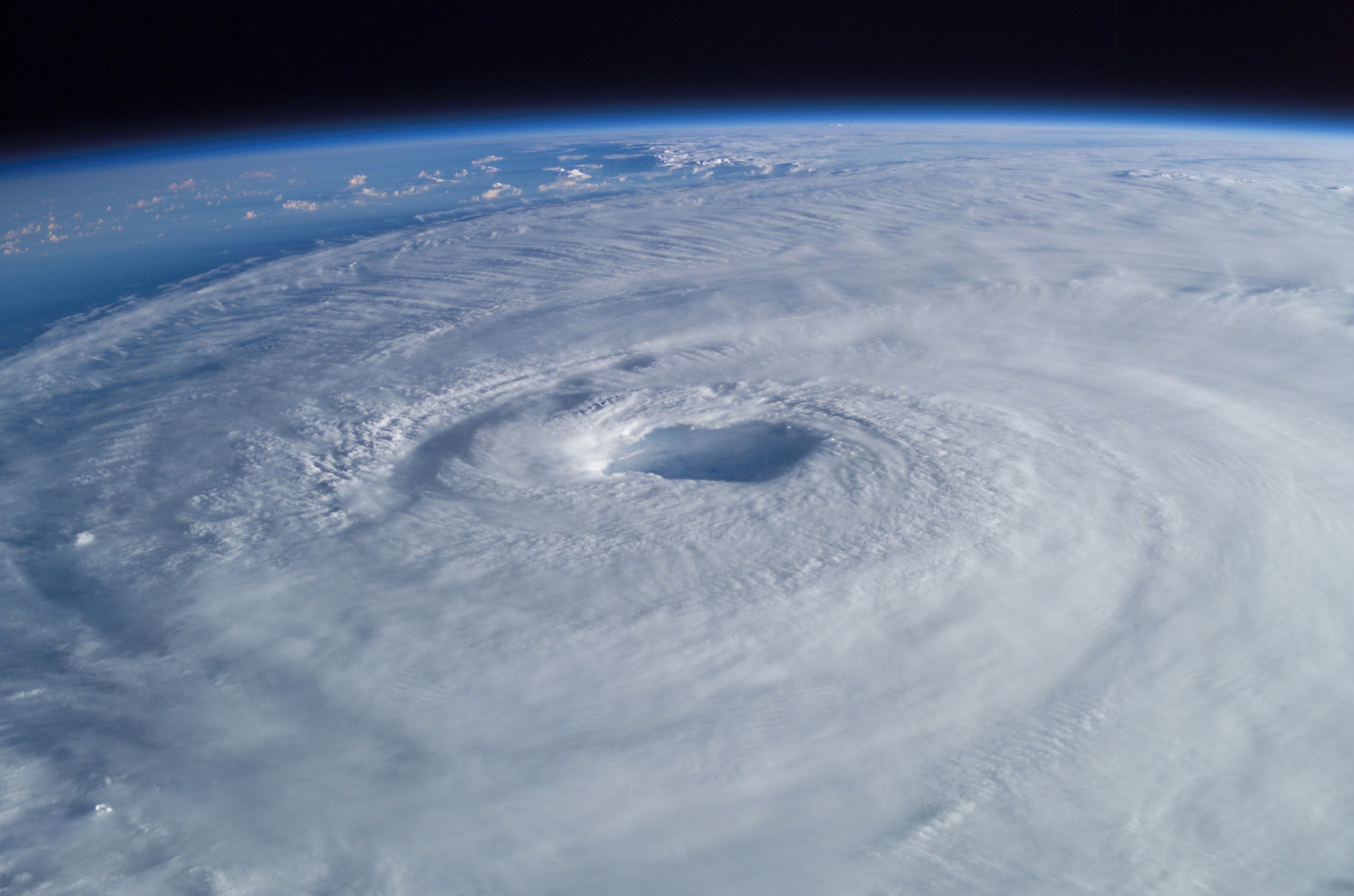
Hurricane Isabel from the ISS. Courtesy of Wikipedia.
Other proposed ways to modify hurricanes include the use of barges with upward-pointing jet engines to trigger smaller storms to disrupt the progress of a hurricane (though this was never tested, as many believed the jets would not be strong enough to make any difference) and the pouring of environmentally-friendly oils on the ocean surface to prevent evaporation and cloud formation (this, too, was later discounted as ineffective).
Some scientists believe there may be a possibility of controlling weather in the future from space. One idea is the heating of large hurricanes at certain critical points, in an effort to steer the cyclones a bit.
Finally, as with cloud seeding, weather modification in general could have the following problems:
- Effectiveness (most proposed methods have been shown to have little to no effect on the weather)
- Legal issues
- Unintended side effects (weather is chaotic and may not always respond the way you think)
- Damage to existing ecosystems (see Monday’s post…we may need storms and certain weather to maintain good living conditions for people, animals, and plants)
- Health risks
- Use as a weapon
In the meantime, the best we can probably hope for is to warn people of certain weather events ahead of time and to educate people on what they should do to protect life and property when dangerous storms do occur.
So what are your thoughts on weather modification? Should we attempt it? Why or why not?
Permalink
« Previous Page — « Previous entries « Previous Page · Next Page » Next entries » — Next Page »






